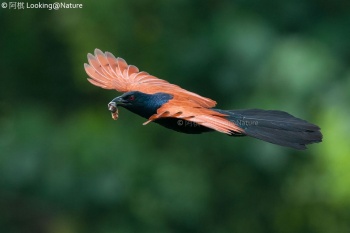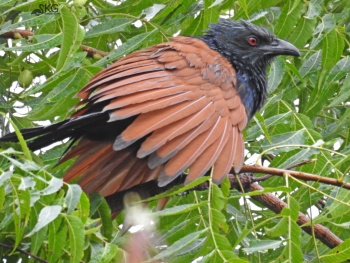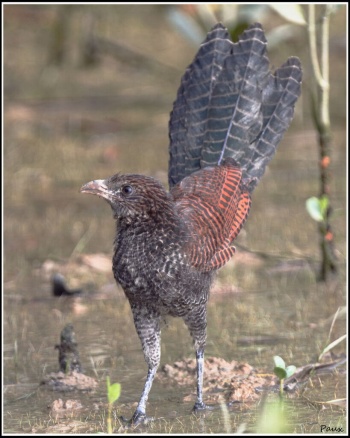Alternative names: Common Crow Pheasant
- Centropus sinensis
Identification
These are large members of the Cuckoo family, 47 - 52cm (18½-20½ in).
- Black head
- Black, glossed purple upper mantle and underparts
- Chestnut back and wings
- Lack pale shaft streaks on the coverts
- Red eyes
Juvenile
- Duller black with spots on the crown
- Whitish bars on the underside and tail
Variations
kangeanensis has pale buff head and body and a grey tail, also a dark morph with grey throat and mottled grey breast
Distribution
Found in southeast Asia from India east to south China, Indochina and Indonesia.
Widespread and common in most of its range.
Taxonomy
Forms a superspecies with Andaman Coucal. parroti is sometimes split as Southern Coucal.
Subspecies
There are 6 subspecies[1]:
- C. s. sinensis:
- C. s. parroti:
- C. s. intermedius:
- Bangladesh to Myanmar, southern Thailand, Indochina and Malay Peninsula
- C. s. bubutus:
- Greater Sundas and adjacent islands to south-western Philippines
- C. s. anonymus:
- Southern Philippines (Jolo, Tawitawi, Basilan and Sanga Sanga)
- C. s. kangeangensis:
- Kangean Islands (Java Sea)
An additional subspecies, eurycercus is generally considered invalid[1].
Habitat
Scrubland, secondary forest, tall grassland, thickets, paddyfields, mangroves, bamboo and gardens. Avoids dense primary forest.
Occurs from lowlands up to 1200m, occasionally up to 2100m.
Behaviour
Wanders around like a pheasant, but walks more like a raven. The are well known for sunbathing with wings open wide.
When disturbed they make short flights with shallow wing beats and brief glides into cover.
Diet
Feeds on small mammals, lizards, snakes, frogs, insects, scorpions, spiders, snails, slugs, eggs and nestlings of small birds, fruits and seeds.
Breeding
Breeding season in the rains, mainly from June to September in northern India, all year in southern India and Sri Lanka. A monogamous species. The nest is a large globular cell made of twigs and leaves and with a lateral entrance. It's hidden in a thick bush or low in a thorny tree or in a paddfield. Lays 2 to 4 eggs.
Movements
This is a resident species.
Vocalisation
Recording by Alok Tewari
Keoladeo National Park, India, June-2013
One individual sitting on top of a stunted tree and calling during peak summer. Calls by Indian Peafowl, Jungle Babbler, Grey Francolin and White-breasted Kigfisher can also be heard in the BG.
References
- Clements, J. F., T. S. Schulenberg, M. J. Iliff, S. M. Billerman, T. A. Fredericks, B. L. Sullivan, and C. L. Wood. 2019. The eBird/Clements Checklist of Birds of the World: v2019. Downloaded from http://www.birds.cornell.edu/clementschecklist/download/
- Del Hoyo, J, A Elliot, and J Sargatal, eds. 1997. Handbook of the Birds of the World. Volume 4: Sandgrouse to Cuckoos. Barcelona: Lynx Edicions. ISBN 978-8487334221
- Bird Forum Member observations
Recommended Citation
- BirdForum Opus contributors. (2024) Greater Coucal. In: BirdForum, the forum for wild birds and birding. Retrieved 26 April 2024 from https://www.birdforum.net/opus/Greater_Coucal
External Links








